Lissa Johnston's Blog, page 23
April 5, 2016
Eleonora Sears Wears The Pants
 Sears shocks the horsey set by wearing pants to play polo.
Sears shocks the horsey set by wearing pants to play polo. Would have been more shocking if she played
without them IMO.So I'm minding my own business, browsing my Twitter feed, when I see a tweet about a woman I had never heard of who was known as 'The Universal Female Athlete'. For an amateur historian interested in women's studies, this is the ultimate click bait! I must know more! So click I did. This led me to the original tweet by the great folks at the National Womens History Museum. And on I went until my ultimate destination, an opportunity to purchase a biography of my quarry, Eleonora Sears.
Several links on Ms. Sears regurgitated the same handful of interesting facts. But the deeper I dug, the more great info I found.
The original tweet I saw featured a photo of Ms. Sears at the polo fields. Her attire (wearing pants) resulted in strong criticism and pearl-clutching from the stuffed shirts and corsets in Newport. Sears was an expert horsewoman and polo player. She also won several tennis championships. But her athletic prowess didn't end there. Eleonora Spears was also expert at just about every physical endeavor she attempted, to wit:
 It's only 47 miles
It's only 47 milesWalking - endurance walking was a thing in the 1920s. In fact a guy named Weston the Pedestrian was the Michael Jordan of his day. We're not talking walking two blocks to the local liquor store that seems like two miles when you run out of wine. We're talking dozens, hundreds, even thousands of miles. Sears once won a $1000 bet from a friend who bet her she couldn't walk the 47 miles between his house in Providence, RI and hers in Boston in under 15 hours. She did it in under 10. driving - considered an extreme sport in her day. Come to think of it, still is in some sectors (yes, Dallas TX I am looking at YOU)badmintonyachtingswimminghockeysquash
Once when asked if she played squash, she replied, "No, but I could." She took up the game, and became the first female national squash champion in 1946. It's no wonder she earned the moniker, 'Universal Female Athlete'.
Sears was a real stuff-starter. There was nothing she liked better than being told 'no'. Women can't smoke at the club? Exactly why I didn't bring my ciggies - can I bum one from you? Women can't wear pants? Okay, see you at the polo field. Look for a woman wearing pants. Women can't drive? Tell that to the car dealer I just drove home from.
It didn't hurt that she was wealthy. Loaded. Old school, high society, related-to-the-Vanderbilts wealthy. She had the resources to do as she pleased. She chose to remain single, leaving plenty of time for pursuing whatever tickled her fancy. And what tickled Eleonora Sears was learning new things and becoming the best at them that she could. Sounds good to me.
Published on April 05, 2016 08:45
April 4, 2016
Deco Still Dazzles
 Dancing Couples by Anne Harriet FishI recently discovered a darling little television program called
Miss Fisher's Murder Mysteries
. There's much to enjoy here. It's a whodunit, which I adore (we'll talk about my Sherlock addiction in a future post). The lead character and much of the cast is female, which is refreshing. But what really drew me in was the setting. It's set in Melbourne, Australia in the 1920s. Fortuitously, Miss Fisher has loads of cash and is a real clothes horse, so they go nuts dressing her in the most amazing outfits from that era.
Dancing Couples by Anne Harriet FishI recently discovered a darling little television program called
Miss Fisher's Murder Mysteries
. There's much to enjoy here. It's a whodunit, which I adore (we'll talk about my Sherlock addiction in a future post). The lead character and much of the cast is female, which is refreshing. But what really drew me in was the setting. It's set in Melbourne, Australia in the 1920s. Fortuitously, Miss Fisher has loads of cash and is a real clothes horse, so they go nuts dressing her in the most amazing outfits from that era.The clothes are great, the hair is great, but one of my favorite aspects of the 1920s is the Art Deco style. According to our friends at Wiki, Art Deco peaked in the 1920s. Like many things beyond ultra cool and fashionable, this art style originated in France. It features bold colors and uncluttered geometric shapes. Its emphasis on the glory of the man-made often renders something of an homage to the mechanical and industrial boom taking place in society after World War I.
The 1920s were a pivotal era, ushering in a phenomenal amount of societal change in a relatively short time. It's often said the invention of the mobile phone and the Internet have impacted society in an unprecedented way. But consider the contributions of the Roaring Twenties: the impact of electricity, and the automobile. And with the coming of electricity, the domino effect of mass media in the form of radio and later, television and movies, both silent and talkie. Factor in the perfect media storm of electricity, media, and entertainment that spawned the cult of celebrity worship that dominates our current news cycle. They're all still going strong more than one hundred years after their debut. It's only fitting that such a magnificent age is represented by such a magnificent artistic style.
Dancing Couples by artist Anne Harriet Fish appeared as a Vanity Fair cover design March 1921. It's part of the Swann Collection of Caricature and Cartoon available through the Library of Congress Digital Collection.
Published on April 04, 2016 19:08
April 3, 2016
Creativity: The Cleaning Connection
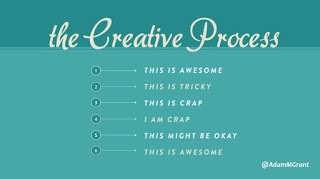 Catching up on cleaning out my emails today, and something happened that I often hope for but rarely experience: finding something outstanding buried among the detritus of newsletters and sales pitches I really need to unsub from. It was a link to a TED Talk by Adam Grant in which he discussed, among many other fabulous things, the science behind adding just the right touch of procrastination to the creative process.
Catching up on cleaning out my emails today, and something happened that I often hope for but rarely experience: finding something outstanding buried among the detritus of newsletters and sales pitches I really need to unsub from. It was a link to a TED Talk by Adam Grant in which he discussed, among many other fabulous things, the science behind adding just the right touch of procrastination to the creative process.I'm not going to go into a lot of detail about the TED Talk for you because I really encourage you to take about 16 minutes and watch the whole thing. But to the point of procrastinating: Grant quotes Aaron Sorkin, the successful creative mind behind many hits including two of my favorites, The West Wing and Moneyball:

Grant, who is an organizational psychologist, shared some statistics indicating that people who procrastinate just the right amount (just a little bit), at just the right time (after the project has begun, not before), often have better results with their end product than people who don't. Because SCIENCE.
Now that we have permission from the creativity experts to goof off (like we weren't gonna goof off today anyway *snort*), I can feel A-OK about my procrastination activity of choice: cleaning AKA ProcrastiCleaning. I know some of you are out there shaking your head, wondering why in the name of all that is holy, if I now have permission to goof off, I'm wasting precious goof-off time on such a mundane activity.
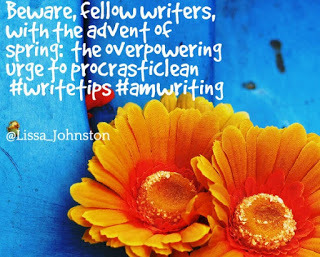 I wish I had an answer. I don't even LIKE to clean. I mean, I'm not a hoarder or anything, but at my house on any given day, one might find a layer of dust or a carpet that needs vacuuming if one were to look especially carefully. I'll clean, but I don't especially enjoy the experience. Unless there's writing to be done. The closer the deadline, the better I like it. Then I'll clean like a banshee. And I don't mean dusting and vacuuming. We're talking major cleaning jobs, like detailing the car. Or taking a toothbrush to the knots in the heart pine flooring to get every bit of Sheetrock dust from a recent project out of there. Or possibly disassemble-the-plumbing-under-the-bathroom-double-vanity-to-scrape-out-the-mysterious-crud-inside-the pipes-under-my-husband's-sink (but not mine!) cleaning. Not that I would ever do that. In any case, ProcrastiCleaning is not for the faint of heart (or knee, or back).
I wish I had an answer. I don't even LIKE to clean. I mean, I'm not a hoarder or anything, but at my house on any given day, one might find a layer of dust or a carpet that needs vacuuming if one were to look especially carefully. I'll clean, but I don't especially enjoy the experience. Unless there's writing to be done. The closer the deadline, the better I like it. Then I'll clean like a banshee. And I don't mean dusting and vacuuming. We're talking major cleaning jobs, like detailing the car. Or taking a toothbrush to the knots in the heart pine flooring to get every bit of Sheetrock dust from a recent project out of there. Or possibly disassemble-the-plumbing-under-the-bathroom-double-vanity-to-scrape-out-the-mysterious-crud-inside-the pipes-under-my-husband's-sink (but not mine!) cleaning. Not that I would ever do that. In any case, ProcrastiCleaning is not for the faint of heart (or knee, or back).  Apparently, I'm not alone. I can tell by the number of 'Amen, sistah!' responses on social media any time the subject comes up. And those are just from the ProcrastiCleaners who are loud and proud and out of the cleaning closet. For each of them, I'm sure there are twenty more writers out there, still pretending they are actually straight-up cleaning rather than avoiding a deadline. Never mind they just spent forty minutes learning how to use the attachments on the vacuum so they can Hoover the funnel cloud of dust bunnies out from under the guest room dresser. BTW Rookie Mistake: dead giveaway that you're ProcrastiCleaning if you're considering learning how to use the attachments on the vacuum.I know cleaning to avoid writing is weird (if not bordering on counter-productive). I can't help it. But I'm not about to give it up. I have my best ideas while doing mindless non-writing-related tasks. And they're not limited to cleaning. Once I almost punctured my trachea in my haste to write down a plot twist idea I got while brushing my teeth.
Apparently, I'm not alone. I can tell by the number of 'Amen, sistah!' responses on social media any time the subject comes up. And those are just from the ProcrastiCleaners who are loud and proud and out of the cleaning closet. For each of them, I'm sure there are twenty more writers out there, still pretending they are actually straight-up cleaning rather than avoiding a deadline. Never mind they just spent forty minutes learning how to use the attachments on the vacuum so they can Hoover the funnel cloud of dust bunnies out from under the guest room dresser. BTW Rookie Mistake: dead giveaway that you're ProcrastiCleaning if you're considering learning how to use the attachments on the vacuum.I know cleaning to avoid writing is weird (if not bordering on counter-productive). I can't help it. But I'm not about to give it up. I have my best ideas while doing mindless non-writing-related tasks. And they're not limited to cleaning. Once I almost punctured my trachea in my haste to write down a plot twist idea I got while brushing my teeth. This month I'm trying to salvage the brain dump also known as last November's NaNoWriMo upchuck. Now that the plumbing project is done, I need to go fire up the hub's power washer. Thank goodness for pollen season, or I'd have no prayer of meeting my deadline.
Published on April 03, 2016 10:06
April 2, 2016
Baseball, Baby!
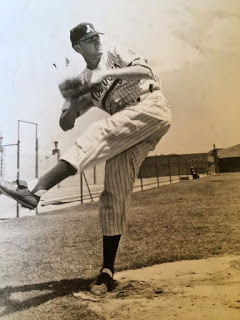 My dad, Clifford 'Red' Jones
My dad, Clifford 'Red' Jonespitching for the Alpine CowboysTomorrow we will be rescued from two months of ho-hum televised sports viewing with opening of the 2016 baseball season. Huzzah!
I know, I know, baseball has an image problem. The fan base is shrinking. Many consider it boring. You know what? I don't care. I feel the same way about certain sports, so, non-baseball fans, I share your pain. You watch your stupid boring sport, and I'll watch something worth watching.
Okay, full disclosure: I have powerful, sentimental motivation to follow a sport that admittedly can be a bit of a slog if you're not familiar with the game. My dad was a multi-sport athlete in high school and earned a baseball scholarship to Sul Ross University in Alpine, Texas (my birthplace). Alpine is out in the far west mountainous triangle-shaped frontier of Texas. Back then it was just a wide spot on the road. but it was a real baseball hotspot due to the obsession of wealthy rancher Herbert Kokernot. Dad played for Mr. Kokernot's Alpine Cowboys until he was signed by the Milwaukee Braves in 1956. He pitched for the Braves in their farm system for a few years before realizing the baseball biz wasn't likely to support his growing family. Oh, how times have changed.
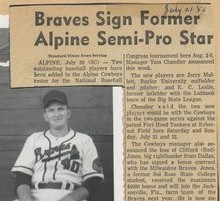 Opening Day always opens the memory floodgates of our family baseball lore. There's the tawdry yet amusing shenanigans of baseball wives (told by my mom - about other wives, natch - Dad claims no knowledge of any such goings on). Mom does wish we'd quit telling about the time she dashed out of her seat to dodge an incoming foul ball tip, leaving me behind, an innocent, guileless infant, blissfully unaware of the 70 mph cowhide-wrapped bullet of death about to rain down on my head. Handy tip: foul tips are possibly the lone disadvantage of players' wives getting those great seats behind the home dugout.
Opening Day always opens the memory floodgates of our family baseball lore. There's the tawdry yet amusing shenanigans of baseball wives (told by my mom - about other wives, natch - Dad claims no knowledge of any such goings on). Mom does wish we'd quit telling about the time she dashed out of her seat to dodge an incoming foul ball tip, leaving me behind, an innocent, guileless infant, blissfully unaware of the 70 mph cowhide-wrapped bullet of death about to rain down on my head. Handy tip: foul tips are possibly the lone disadvantage of players' wives getting those great seats behind the home dugout.I would love to show you the hilarious grainy video of the players milking cows on the mound as a publicity stunt, but due to some technical difficulties, that will have to wait. Luckily for my dad, he was a country boy born and raised. He knew his way around a set of udders just as well as he did a baseball diamond.
I am able to share with you an example of the requisite yellowed newspaper clippings like the one here, bragging up my dad as 'the big righthander' and 'fireballer' and the pitcher of not one but TWO shutouts in post-season play as a highschooler. Ain't no thang. Just two shutouts. In two appearances. Probably in the same week. Yawn.
This is why, at the Jones household, we understand why the baseball pitcher's arm is considered the most valuable body part in professional sports. This is why the Rangers' devastating loss to the Cardinals in the sixth game of the 2011 World Series still gets me a little choked up (we will not speak of this *sniff*). And this is why I'm so freakin' pumped for baseball season to start. Got the hat. Got the shirt. Got the remote. Let the games begin.
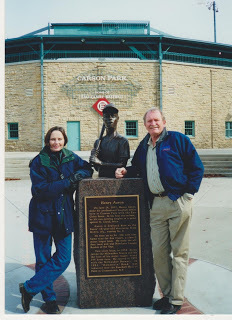 Dad and I paying homage to another Brave
Dad and I paying homage to another BraveEau Claire WI 1999
Published on April 02, 2016 07:39
April 1, 2016
April Fools Aspirations
 We writers often lead a secluded, sequestered life. It is said many of us are introverts. We prefer it that way. Combine this with a WFH schedule, and I often find myself unprepared for April Fool's Day hijinx. I forget all about it date-wise, and therefore am easy prey for Internet scams, like the one promising the Firefly series would be revived on Netflix; or the one touting an X-Files comeback (if you consider that fiasco in January a comeback, the joke's on you).
We writers often lead a secluded, sequestered life. It is said many of us are introverts. We prefer it that way. Combine this with a WFH schedule, and I often find myself unprepared for April Fool's Day hijinx. I forget all about it date-wise, and therefore am easy prey for Internet scams, like the one promising the Firefly series would be revived on Netflix; or the one touting an X-Files comeback (if you consider that fiasco in January a comeback, the joke's on you).I never think of April Fools that I don't wring my hands over whether or not to include an apostrophe. And also over the family lore of the time my dad thought it would be hilarious to break up with my mom in high school and let her think it was for real until almost the end of the day. Pretty sure when he bopped up to her locker that afternoon and said, "April Fool!", he's lucky he made it home with all his teeth. Strangely, Dad is now known for his sense of humor and comic timing. I guess he was still learning the ropes back then.
I like a good laugh as well as anyone. Much of the April Fool's horseplay has always struck me as dominated by the adolescent male bathroom humor types. They're either too silly, too gross, or do a poor job of disguising their latent cruelty. I know that makes me sound like a sourpuss. But I can appreciate an April Fools prank if it's done well.
I fondly recall the time, 30-odd years ago now, that I was roped in by one of the greatest April Fool's pranks of all time: the Sports Illustrated story by George Plimpton that ran in 1985 about a phenom baseball pitcher. I devoured the entire article, mouth agape, which got very messy as I was simultaneously salivating over the thought of watching this kid play in the upcoming season. It never occurred to me that it was a hoax until I heard a few days later. And it was such a gloriously prepared prank, I wasn't even mad about it. I spent no small amount of time turning it over in my mind like a piece of journalistic pyrite, marveling over how they pulled it off. That's the kind of prank I like - something so original and well thought out and perfectly executed, so very Sting-like (the movie, not the singer) that you can't feel too badly about being hornswoggled. They set the bar pretty high. Somehow, Vaseline on the doorknob and plastic wrap over the toilet seat just pale in comparison.
It's been a while since anyone Fooled me on April 1. No fake break-ups with the ensuing lawsuits and dental bills. No tiresome Whoopie cushions or rubber snakes. I keep waiting for another great fake article from those devilish tricksters at Sports Illustrated. I understand why they can't run one every year. But I haven't read this week's SI yet. There's still hope.
Published on April 01, 2016 18:09
March 27, 2016
Norwegians - in Texas??
The main character of my most recent book, The Dala Horse, is a 10-year-old girl growing up in a Norwegian immigrant settlement in post-Civil War Texas. Her parents were born in Norway, but she was born in Texas. The book is inspired by the early Norwegian immigrants to Texas, including my own ancestors.
People are usually surprised to learn there are Norwegians in Texas. While it’s true most Norwegian immigrants to America settled farther north, some intrepid souls did choose the Lone Star State.
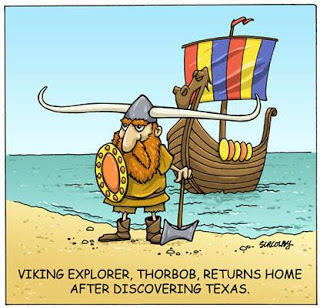 The definitive proof . . .Norwegian immigrants came to America in three major waves in the second half of the 19th century. But the earliest came during an economic downturn after the Napoleonic Wars 1807-1814.
The definitive proof . . .Norwegian immigrants came to America in three major waves in the second half of the 19th century. But the earliest came during an economic downturn after the Napoleonic Wars 1807-1814.
Norway had outgrown its ability to provide enough food for its population. If you imagine Norway is a top hat, only the narrow brim is practical for farming due to the mountainous terrain. In the 1800s, only about 3% of its land was under cultivation, mainly due to Norway’s geography.
In addition, prosperous farmers who invested in commercial agriculture to take advantage of this imbalance lost out when domestic markets fell to cheap imports. Many went bankrupt.
Faced with a transition from an agricultural to a money economy, many found immigration more attractive than moving to cities. After all, exploration and adventure was in their Viking blood! Pair this with the generous land policies in Texas, and it's easy to see why so many were willing to risk the journey.
Immigration was also fueled by the 19th century version of social media: newspapers, magazines, and letters from friends who had already moved away and liked the result.
Early emigration proponents included
Cleng Peerson of the sloop Restauration fame (the ‘father of Norwegian immigration’) Johan Reinert Reiersen, author of Norway’s first emigration-centric magazine, Norge og Amerika Elise Waerenskjold, the ‘Lady With The Pen’ All three had tremendous influence on Norwegian immigration patterns. All spent their final years in Texas and are buried there.
Of the three, Reiersen perhaps had the most impact bringing Norwegians to Texas. He visited the fledgling republic while touring America in the 1840s. He traveled to Austin and met with Sam Houston.
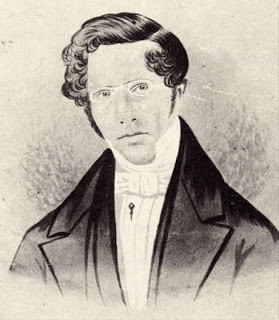 Johan Reinert ReiersenReiersen was favorably impressed by Houston’s offers of support for any immigrants choosing Texas as their new home. Reierson’s book, magazine, and newspaper articles influenced many to join him there.
Johan Reinert ReiersenReiersen was favorably impressed by Houston’s offers of support for any immigrants choosing Texas as their new home. Reierson’s book, magazine, and newspaper articles influenced many to join him there.
He and a small group of settlers founded the first Norwegian community in Texas in 1845. Initially called Normandy, today it is known as Brownsboro.
(However, they were not the first Norwegian settlers in Texas. That would be Johannes Nordboe, who had settled near present day Dallas in 1838.)
Cheap land - and plenty of it! - undoubtedly was a major factor in convincing immigrants to move to Texas. After Texas became a state in 1845, a married couple could claim a 640 acre section (one square mile). At that time, the average farm in Norway was 2-20 acres.
Not 220.
Between TWO and TWENTY.
The process of staking a claim in Texas varied, but went something like this:
claim the land establish a home and cultivate at least 10 acresoccupy at least 3 yearspay for surveyAnd the land was yours, for anywhere from free to $2/acre.
No wonder immigrating to Texas sounded like a pretty good deal! The land was plentiful and cheap, but that was only a small part of the cost to immigrate. Immigration was booming. The ship captains were no dummies, and fares were at a premium.
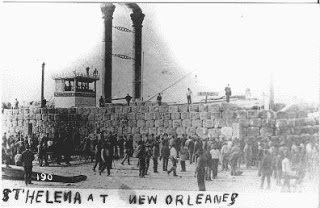 As an example, immigrant one immigrant's fare on the ship New England from France to New Orleans was about $950. The fare on the riverboat St. Helena was $75 from New Orleans to Shreveport.
As an example, immigrant one immigrant's fare on the ship New England from France to New Orleans was about $950. The fare on the riverboat St. Helena was $75 from New Orleans to Shreveport.
And this does not include her voyage from Norway to France. Or traveling overland from New Orleans to her final destination in Texas. One inflation calculator estimates $100 in 1847 to be worth about $2,750 today. Using that formula, her relocation to America cost around $30,000. And this was certainly not for first class accommodations. She traveled below decks with all the other passengers, and cargo, and animals.
After all the trouble and expense of immigrating from Norway to Texas, the original settlement of Normandy did not live up to the settlers’ expectations. Illness and other factors precipitated a relocation in 1848 to nearby Four Mile Prairie/Prairieville. More settlers arrived in 1850, bringing the Norwegian contingent to 105. Still seeking better quality soil and water, many Norwegians pushed further west in 1854 when Bosque County was created. The communities of Clifton, Cranfills Gap, and Norse became the Norwegian stronghold in the state.
The Bosque County location proved most successful for the Norwegian immigrants. Today it is home to Norse heritage resources such as the Bosque Museum and the Cleng Peerson Institute.

Norwegian settlements1 - Normandy2 - Four Mile/Prairieville3 - Bosque County
Census records of the time reflect a slow but steady influx of Norwegians.
Statewide population of Norwegians in Texas1860 = 3211870 = 5521880 = 941
One estimate of the number of Texans of Norwegian descent today is around 129,000.
Several Norwegian societies have chapters in Texas, including
Sons of NorwayDaughters of NorwayNorwegian Society of TexasScandinavian Friends
Fun facts about Texas Norwegians, or 'Texwegians'
At one time, Norway was second only to Ireland in percentage of population immigrating to AmericaNotable Texwegians include: Ole Ringness, the inventor of the disc plow Athlete Babe DidriksonIn Norway, people use the word ‘Texas’ as slang for ‘crazy’
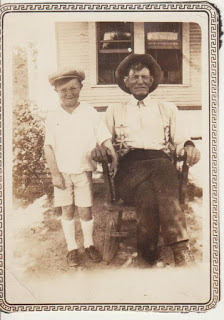 My great-grandfather Ole Olson
My great-grandfather Ole Olson
with his son Kenneth ca 1930For more Texwegian fun, check out my book, The Dala Horse, now available for $0.99 on Amazon.
10-year-old Kaya Olson lives in a small Norwegian immigrant settlement in post-Civil War Texas. When her mother is killed, Kaya feels responsible. Can she uncover the secrets her family is keeping to solve the mystery surrounding her mother’s death?
People are usually surprised to learn there are Norwegians in Texas. While it’s true most Norwegian immigrants to America settled farther north, some intrepid souls did choose the Lone Star State.
 The definitive proof . . .Norwegian immigrants came to America in three major waves in the second half of the 19th century. But the earliest came during an economic downturn after the Napoleonic Wars 1807-1814.
The definitive proof . . .Norwegian immigrants came to America in three major waves in the second half of the 19th century. But the earliest came during an economic downturn after the Napoleonic Wars 1807-1814.Norway had outgrown its ability to provide enough food for its population. If you imagine Norway is a top hat, only the narrow brim is practical for farming due to the mountainous terrain. In the 1800s, only about 3% of its land was under cultivation, mainly due to Norway’s geography.
In addition, prosperous farmers who invested in commercial agriculture to take advantage of this imbalance lost out when domestic markets fell to cheap imports. Many went bankrupt.
Faced with a transition from an agricultural to a money economy, many found immigration more attractive than moving to cities. After all, exploration and adventure was in their Viking blood! Pair this with the generous land policies in Texas, and it's easy to see why so many were willing to risk the journey.
Immigration was also fueled by the 19th century version of social media: newspapers, magazines, and letters from friends who had already moved away and liked the result.
Early emigration proponents included
Cleng Peerson of the sloop Restauration fame (the ‘father of Norwegian immigration’) Johan Reinert Reiersen, author of Norway’s first emigration-centric magazine, Norge og Amerika Elise Waerenskjold, the ‘Lady With The Pen’ All three had tremendous influence on Norwegian immigration patterns. All spent their final years in Texas and are buried there.
Of the three, Reiersen perhaps had the most impact bringing Norwegians to Texas. He visited the fledgling republic while touring America in the 1840s. He traveled to Austin and met with Sam Houston.
 Johan Reinert ReiersenReiersen was favorably impressed by Houston’s offers of support for any immigrants choosing Texas as their new home. Reierson’s book, magazine, and newspaper articles influenced many to join him there.
Johan Reinert ReiersenReiersen was favorably impressed by Houston’s offers of support for any immigrants choosing Texas as their new home. Reierson’s book, magazine, and newspaper articles influenced many to join him there.He and a small group of settlers founded the first Norwegian community in Texas in 1845. Initially called Normandy, today it is known as Brownsboro.
(However, they were not the first Norwegian settlers in Texas. That would be Johannes Nordboe, who had settled near present day Dallas in 1838.)
Cheap land - and plenty of it! - undoubtedly was a major factor in convincing immigrants to move to Texas. After Texas became a state in 1845, a married couple could claim a 640 acre section (one square mile). At that time, the average farm in Norway was 2-20 acres.
Not 220.
Between TWO and TWENTY.
The process of staking a claim in Texas varied, but went something like this:
claim the land establish a home and cultivate at least 10 acresoccupy at least 3 yearspay for surveyAnd the land was yours, for anywhere from free to $2/acre.
No wonder immigrating to Texas sounded like a pretty good deal! The land was plentiful and cheap, but that was only a small part of the cost to immigrate. Immigration was booming. The ship captains were no dummies, and fares were at a premium.
 As an example, immigrant one immigrant's fare on the ship New England from France to New Orleans was about $950. The fare on the riverboat St. Helena was $75 from New Orleans to Shreveport.
As an example, immigrant one immigrant's fare on the ship New England from France to New Orleans was about $950. The fare on the riverboat St. Helena was $75 from New Orleans to Shreveport.And this does not include her voyage from Norway to France. Or traveling overland from New Orleans to her final destination in Texas. One inflation calculator estimates $100 in 1847 to be worth about $2,750 today. Using that formula, her relocation to America cost around $30,000. And this was certainly not for first class accommodations. She traveled below decks with all the other passengers, and cargo, and animals.
After all the trouble and expense of immigrating from Norway to Texas, the original settlement of Normandy did not live up to the settlers’ expectations. Illness and other factors precipitated a relocation in 1848 to nearby Four Mile Prairie/Prairieville. More settlers arrived in 1850, bringing the Norwegian contingent to 105. Still seeking better quality soil and water, many Norwegians pushed further west in 1854 when Bosque County was created. The communities of Clifton, Cranfills Gap, and Norse became the Norwegian stronghold in the state.
The Bosque County location proved most successful for the Norwegian immigrants. Today it is home to Norse heritage resources such as the Bosque Museum and the Cleng Peerson Institute.

Norwegian settlements1 - Normandy2 - Four Mile/Prairieville3 - Bosque County
Census records of the time reflect a slow but steady influx of Norwegians.
Statewide population of Norwegians in Texas1860 = 3211870 = 5521880 = 941
One estimate of the number of Texans of Norwegian descent today is around 129,000.
Several Norwegian societies have chapters in Texas, including
Sons of NorwayDaughters of NorwayNorwegian Society of TexasScandinavian Friends
Fun facts about Texas Norwegians, or 'Texwegians'
At one time, Norway was second only to Ireland in percentage of population immigrating to AmericaNotable Texwegians include: Ole Ringness, the inventor of the disc plow Athlete Babe DidriksonIn Norway, people use the word ‘Texas’ as slang for ‘crazy’
 My great-grandfather Ole Olson
My great-grandfather Ole Olson with his son Kenneth ca 1930For more Texwegian fun, check out my book, The Dala Horse, now available for $0.99 on Amazon.
10-year-old Kaya Olson lives in a small Norwegian immigrant settlement in post-Civil War Texas. When her mother is killed, Kaya feels responsible. Can she uncover the secrets her family is keeping to solve the mystery surrounding her mother’s death?
Published on March 27, 2016 12:46
March 20, 2016
From One Norwegian Texan To Another
Sad news to report, but it has a small sliver of silver lining (a sliver lining, perhaps?). My uncle
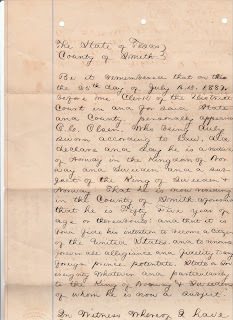 passed away recently. His daughter, my first cousin, was looking for photos and other documents to help her write his obituary and make a presentation for his memorial service. She knew I had some papers that belonged to our grandmother (my uncle's mother) and I offered to look through them to see if there was anything she might want.
passed away recently. His daughter, my first cousin, was looking for photos and other documents to help her write his obituary and make a presentation for his memorial service. She knew I had some papers that belonged to our grandmother (my uncle's mother) and I offered to look through them to see if there was anything she might want.
I didn't find what she was looking for - it's okay, we found it somewhere else - but I did find something I had overlooked for many years: my great-great-grandfather Ole Olson's 'declaration of intention' to become a U. S. citizen. It was dated July 25, 1887, sworn before the district court clerk in Smith Co., Texas (Tyler area). Here's a transcript of the letter in case you can't read the image:
The State of TexasCounty of Smith
Be it remembered that on this the 25th day of July A. D. 1887, before me Clerk of the District Court in and for said State and County, personally appeared O. I. Olsen, Who being duly sworn according to law, did declare and say his is a native of Norway in the Kingdom of Norway and Sweeden. and as a subject of the King of Sweeden & Norway that he is now residing in the County of Smith aforesaid. That he is Fifty Five years of age or thereabouts and that it is bona fide his intention to become a citizen of the United States and to renounce forever all allegiance and fidelity to any foreign prince potentate state or sovereignty whatever and particularly to the King of Norway & Sweeden of whom he is now a subject.
In Witness whereof I have hereunto set my hand and affixed the seal of said county this 26th day of July A. D. 1887.
E. S. CookClerk District CourtSmith Co. Tex.
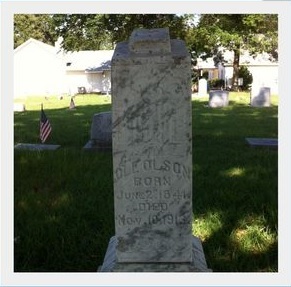 Fascinating stuff! Several nuggets of family tree gold here.
Fascinating stuff! Several nuggets of family tree gold here.
This document more or less confirms his approximate age, which corresponds with census and headstone info.It serves as a reminder that Norway and Sweden were united from 1814-1905. My Norwegian ancestors came to Texas in the 1850s.I didn't realize he ever owned property in Smith County. The first Norwegian community in Texas was in Smith County. Originally christened Normandy, the name was later changed to Brownsboro. Normandy turned out to be an unpopular location due to poor soil and water conditions. Many Norse relocated slightly southwest to the Four Mile/Prairieville area straddling the Kaufman and Van Zandt county lines. A final westward migration when Bosque County was created in 1854 proved most successful for the Norwegians, who settled in the Clifton area. But my Olson ancestors and a few others, such as the Waerenskjolds and the Wattners, didn't make that third move. They stayed in Prairieville.
It's usually at about this point that someone says they must have mis-heard me. Did I say there were Norwegians who immigrated to Texas? Why, yes, indeed. More on that in a future blog post.
Back to the naturalization process:
Further checking turned up a very handy document from the Minnesota Historical Society. It's brief and worth a read if you're a genealogist. The gist of it is that the process of becoming a naturalized citizen of the United States was quite simple in the 19th century. You visited a court of record and declared your intention to become a citizen, then returned in five years with a couple of witness who would confirm that you were a great guy (sorry, ladies, since you couldn't vote until 1920 and rarely owned your own land, citizenship wasn't something to worry your pretty head about) and swore the oath of allegiance and cemented the deal. The document I found confirms Grandpa Olson completed the first step. I don't have any further documentation so far to see if he followed through. He died in 1913, so he more than fulfilled the five year waiting period from 1887-1892. If he did follow through, his new citizenship status extended to his wife and any minor children that may have been born elsewhere.
Today the process of becoming a citizen is more complicated, and in light of current world affairs and security concerns, I suppose this is as it should be. Naturalization has come under the purview of the federal government rather than local. There are ten steps now, rather than two. There are forms and fees and tests. It still could take years. You still could get turned down.
I'm glad I found this document, but I'm sad about how I came to be looking through those papers. Turns out my uncle who passed away was also named Ole (Ole Bob, to be specific - after all, we're talking about Texas here). More than 100 years separates me from my Norwegian ancestors who immigrated to Texas. But reminders still manage to pop up in the most unexpected ways.

Now that you know about my Norwegian heritage, maybe that explains why my latest book features a main character who was born in Texas and is a daughter of Norwegian immigrants. The Dala Horse is available now at Amazon.
 passed away recently. His daughter, my first cousin, was looking for photos and other documents to help her write his obituary and make a presentation for his memorial service. She knew I had some papers that belonged to our grandmother (my uncle's mother) and I offered to look through them to see if there was anything she might want.
passed away recently. His daughter, my first cousin, was looking for photos and other documents to help her write his obituary and make a presentation for his memorial service. She knew I had some papers that belonged to our grandmother (my uncle's mother) and I offered to look through them to see if there was anything she might want.I didn't find what she was looking for - it's okay, we found it somewhere else - but I did find something I had overlooked for many years: my great-great-grandfather Ole Olson's 'declaration of intention' to become a U. S. citizen. It was dated July 25, 1887, sworn before the district court clerk in Smith Co., Texas (Tyler area). Here's a transcript of the letter in case you can't read the image:
The State of TexasCounty of Smith
Be it remembered that on this the 25th day of July A. D. 1887, before me Clerk of the District Court in and for said State and County, personally appeared O. I. Olsen, Who being duly sworn according to law, did declare and say his is a native of Norway in the Kingdom of Norway and Sweeden. and as a subject of the King of Sweeden & Norway that he is now residing in the County of Smith aforesaid. That he is Fifty Five years of age or thereabouts and that it is bona fide his intention to become a citizen of the United States and to renounce forever all allegiance and fidelity to any foreign prince potentate state or sovereignty whatever and particularly to the King of Norway & Sweeden of whom he is now a subject.
In Witness whereof I have hereunto set my hand and affixed the seal of said county this 26th day of July A. D. 1887.
E. S. CookClerk District CourtSmith Co. Tex.
 Fascinating stuff! Several nuggets of family tree gold here.
Fascinating stuff! Several nuggets of family tree gold here.This document more or less confirms his approximate age, which corresponds with census and headstone info.It serves as a reminder that Norway and Sweden were united from 1814-1905. My Norwegian ancestors came to Texas in the 1850s.I didn't realize he ever owned property in Smith County. The first Norwegian community in Texas was in Smith County. Originally christened Normandy, the name was later changed to Brownsboro. Normandy turned out to be an unpopular location due to poor soil and water conditions. Many Norse relocated slightly southwest to the Four Mile/Prairieville area straddling the Kaufman and Van Zandt county lines. A final westward migration when Bosque County was created in 1854 proved most successful for the Norwegians, who settled in the Clifton area. But my Olson ancestors and a few others, such as the Waerenskjolds and the Wattners, didn't make that third move. They stayed in Prairieville.
It's usually at about this point that someone says they must have mis-heard me. Did I say there were Norwegians who immigrated to Texas? Why, yes, indeed. More on that in a future blog post.
Back to the naturalization process:
Further checking turned up a very handy document from the Minnesota Historical Society. It's brief and worth a read if you're a genealogist. The gist of it is that the process of becoming a naturalized citizen of the United States was quite simple in the 19th century. You visited a court of record and declared your intention to become a citizen, then returned in five years with a couple of witness who would confirm that you were a great guy (sorry, ladies, since you couldn't vote until 1920 and rarely owned your own land, citizenship wasn't something to worry your pretty head about) and swore the oath of allegiance and cemented the deal. The document I found confirms Grandpa Olson completed the first step. I don't have any further documentation so far to see if he followed through. He died in 1913, so he more than fulfilled the five year waiting period from 1887-1892. If he did follow through, his new citizenship status extended to his wife and any minor children that may have been born elsewhere.
Today the process of becoming a citizen is more complicated, and in light of current world affairs and security concerns, I suppose this is as it should be. Naturalization has come under the purview of the federal government rather than local. There are ten steps now, rather than two. There are forms and fees and tests. It still could take years. You still could get turned down.
I'm glad I found this document, but I'm sad about how I came to be looking through those papers. Turns out my uncle who passed away was also named Ole (Ole Bob, to be specific - after all, we're talking about Texas here). More than 100 years separates me from my Norwegian ancestors who immigrated to Texas. But reminders still manage to pop up in the most unexpected ways.

Now that you know about my Norwegian heritage, maybe that explains why my latest book features a main character who was born in Texas and is a daughter of Norwegian immigrants. The Dala Horse is available now at Amazon.
Published on March 20, 2016 12:15
March 11, 2016
10 Ways To Completely Fail At Podcasting
 A handy little appI'm sitting here in March enjoying a string of delightfully warm spring days before the heat and humidity of summer smacks us cross-eyed. Despite the fabulous weather, I'm feeling a little peeved today. One of my writing goals for 2016 is to try out listening to podcasts as a means of absorbing knowledge about the craft. So I'm fairly new to the whole world of podcasts. It's been simple so far. I have the podcast app on my smart phone. Now when I go for my walk, instead of the same 14 songs in the rotation on Pandora, I listen to podcasts. Multitasking!
A handy little appI'm sitting here in March enjoying a string of delightfully warm spring days before the heat and humidity of summer smacks us cross-eyed. Despite the fabulous weather, I'm feeling a little peeved today. One of my writing goals for 2016 is to try out listening to podcasts as a means of absorbing knowledge about the craft. So I'm fairly new to the whole world of podcasts. It's been simple so far. I have the podcast app on my smart phone. Now when I go for my walk, instead of the same 14 songs in the rotation on Pandora, I listen to podcasts. Multitasking!In the process of learning how best to fit podcasts into my schedule, I've subscribed to a dozen or so of them. I found them either in online articles or a simple search in iTunes. As a result, I have a couple that I really like; one or two more that I'll listen to if I'm all caught up on my favorites; and a few others that are not making the grade.
My favorite, hands down, is Joanna Penn's The Creative Penn. She's been doing regular podcasts since 2008, and it shows. She's an experienced and successful self-published author. Her voice is pleasant. Her topics and guests are interesting. Her interviews are professional and entertaining. The paid promotions are brief. The show notes are thorough and easy to track down if I want more information on something mentioned during the show. This show is the gold standard for writing-related podcasts IMO.
On the other end of the scale, let me describe in very generously anonymous detail why I'm writing this post today. I believe there was some study that said podcasts were the up and coming thing. So everybody with a microphone and two working vocal chords is jumping on the bandwagon. It's similar to the growth of the self-publishing industry, I suppose. People hear of a possible shortcut to making some quick cash and figure, why not? The result also is similar - very uneven quality. You have to kiss a lot of frogs, as they say. If you're thinking of joining the podcast revolution, go right ahead. But please avoid annoying people like me who have social media accounts and (sort of) know how to use them.
How To Avoid Feeling Like I'm Writing This Post About Your Podcast
The #1 thing is prepare-prepare-prepare. As you can probably tell from the Get Off My Lawn tone of this post, I'm of a certain generation. Terry Gross's Fresh Air is the best audio interview program that ever was or ever will be. No one out-prepares Terry Gross. Great topics. Great conversations. Great editors. It's obvious that she reads her guests' books and watches their TV shows and movies and probably eats the same food and drives the same car and uses the same deodorant as her guests, for all I know. I am astonished at how prepared she is. I mean, there are only 24 hours in a day. She must have learned how to manipulate time from one of her guests. It helps to have lots of underlings, I suppose. And of course a professional studio. Speaking of which . . .Quality equipment - none of us are super pumped about listening to your voice echo off the bare walls and hard metal surfaces of your laundry room for an hour. I'm not saying you have to invest thousands in studio time or construction. I found out by accident that closets are a decent place to record if you have no other options. All the clothes make for excellent sound absorption. All I'm saying is, give it some thought and actually listen to some test recordings of yourself before you go live.Anyway - here's what happens when you slack off on the preparation.
You freely admit to your author guest that you didn't plan properly and weren't able to finish their book before the show. Or in fact have not read any of it at all. All you know about it is whatever showed up on the screen shot from their Amazon page. You freely admit, on air with them, that you have no idea how to pronounce their name. Which is perfectly fine, because you doubt you'll even remember their name by tomorrow. Yes, the host actually said this second sentence to the guest during the show. WTF? Apparently it's too much trouble to connect with the guest ninety seconds before air time if you're not 100% sure how to pronounce their name.You freely admit that you have little knowledge of, or interest in, their genre. Your tone indicates no apology or remorse. In fact, you seem to think this is a positive in that there must
 There are some Cousin Eddies of the podcast worldbe millions more people out there who have little interest in this niche and therefore are all potential new readers. Okay, maybe. But if it were me, as host, I don't think I'd mention. There are plenty of ways to have a meaningful conversation with someone on a topic you're not familiar with other than keep circling back to the point that you're not familiar with the topic. Maybe you think it makes you look curious and adventuresome. It might, if you were browsing the bookstore looking for a good weekend read. But as a podcast host, it just makes you look lazy and unprepared.You freely admit you have no idea what the guest's website is. This is no problem, you say, because it'll be in the show notes. See if you can guess how confident I am in your ability to cobble together a quality set of show notes.You have the same set of ten or so lackluster questions that you ask every guest, more or less in the same order. You never stray from this set of questions, even when intriguing conversational opportunities present themselves. This strategy has been known to work in print media (as long as the questions aren't lackluster). It may also be a good guide for audio interviews, so that you don't get too excited during the interview and overlook any important questions. But a well-prepared host needs to be aware of - heck, needs to be praying for - opportunities to explore a compelling line of questioning. Just reading off a list of questions, waiting for the answer, and moving to the next question is a bore. It comes up partway through the interview that the guest had a book promotion that ended two days before the interview was to air. Oh well, says the host, it's a good thing for you we just barely missed your promotion deadline, because now everyone will have to pay more for your book. WTF??You craft a title for your episode for the best possible SEO and social media click bait. It works beautifully, and many listeners tune in. And are subsequently frustrated by having to listen to 47 minutes of blather before getting to the 2:38 of content that actually relate to the topic you advertised. And will unsubscribe from your podcast before you've finished your closing comments. And wish they had that 49:38 minutes of their life back.You ask your guest for ideas on other guests they think your listeners might enjoy, or other podcasts you could guest on to promote your podcast. You ask this during their interview, not privately before or after. Rude much?I already feel guilty enough about carping on these podcast upstarts, so I'm not gonna name names here. The good ones are worthwhile, especially if you have some time to kill during a daily walk or commute. I've gotten some great info listening to The Creative Penn and a few others. But I'm not Terry Gross. I don't have a magical 5 extra hours in every solar day. So I'm pulling the plug on the the Cousin Eddies. Maybe I'll check back with them in a few years when they're better prepared.
There are some Cousin Eddies of the podcast worldbe millions more people out there who have little interest in this niche and therefore are all potential new readers. Okay, maybe. But if it were me, as host, I don't think I'd mention. There are plenty of ways to have a meaningful conversation with someone on a topic you're not familiar with other than keep circling back to the point that you're not familiar with the topic. Maybe you think it makes you look curious and adventuresome. It might, if you were browsing the bookstore looking for a good weekend read. But as a podcast host, it just makes you look lazy and unprepared.You freely admit you have no idea what the guest's website is. This is no problem, you say, because it'll be in the show notes. See if you can guess how confident I am in your ability to cobble together a quality set of show notes.You have the same set of ten or so lackluster questions that you ask every guest, more or less in the same order. You never stray from this set of questions, even when intriguing conversational opportunities present themselves. This strategy has been known to work in print media (as long as the questions aren't lackluster). It may also be a good guide for audio interviews, so that you don't get too excited during the interview and overlook any important questions. But a well-prepared host needs to be aware of - heck, needs to be praying for - opportunities to explore a compelling line of questioning. Just reading off a list of questions, waiting for the answer, and moving to the next question is a bore. It comes up partway through the interview that the guest had a book promotion that ended two days before the interview was to air. Oh well, says the host, it's a good thing for you we just barely missed your promotion deadline, because now everyone will have to pay more for your book. WTF??You craft a title for your episode for the best possible SEO and social media click bait. It works beautifully, and many listeners tune in. And are subsequently frustrated by having to listen to 47 minutes of blather before getting to the 2:38 of content that actually relate to the topic you advertised. And will unsubscribe from your podcast before you've finished your closing comments. And wish they had that 49:38 minutes of their life back.You ask your guest for ideas on other guests they think your listeners might enjoy, or other podcasts you could guest on to promote your podcast. You ask this during their interview, not privately before or after. Rude much?I already feel guilty enough about carping on these podcast upstarts, so I'm not gonna name names here. The good ones are worthwhile, especially if you have some time to kill during a daily walk or commute. I've gotten some great info listening to The Creative Penn and a few others. But I'm not Terry Gross. I don't have a magical 5 extra hours in every solar day. So I'm pulling the plug on the the Cousin Eddies. Maybe I'll check back with them in a few years when they're better prepared.
Published on March 11, 2016 12:18
February 15, 2016
Super Bowl Bonuses: Going Green
My last post was about the history of some of the world championship hardware teams earn when they win a championship. I promised to follow up with the real reason all those players are smiling as they hoist those trophies: their financial bonuses.
According to various sources, the winners of Super Bowl L (50, but as a former Latin student, I'm going old school there) won $97,000.00 each. That's right. Every player on the Denver Broncos roster earned more for winning that game than many people earn in a year. The Panthers each received $49,000.00 for losing it. That will pay for a lot of tissues for wiping away the tears on the plane ride home.
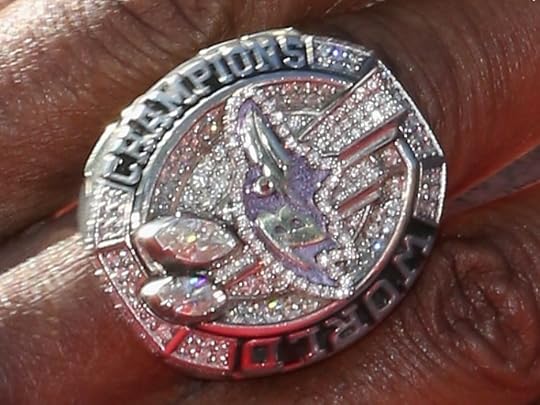 2015 champs blingNinety-seven grand is very grand indeed, but here's the kicker (pun intended): the Super Bowl bonus is literally pocket change for most of the players. The average player salary in the NFL is over $2 million per year. The regular season consists of 16 games, so that works out to about $125,000.00 per game. Teams who reach the Super Bowl have also received bonuses every time they advance in the post-season, so the total bonus take for the champs is closer to $165,000.00 per player. That doesn't include the ring each player will receive after several months of design and manufacture. The rings for last year's champs, the New England Patriots, are valued at $36,500.00 each.
2015 champs blingNinety-seven grand is very grand indeed, but here's the kicker (pun intended): the Super Bowl bonus is literally pocket change for most of the players. The average player salary in the NFL is over $2 million per year. The regular season consists of 16 games, so that works out to about $125,000.00 per game. Teams who reach the Super Bowl have also received bonuses every time they advance in the post-season, so the total bonus take for the champs is closer to $165,000.00 per player. That doesn't include the ring each player will receive after several months of design and manufacture. The rings for last year's champs, the New England Patriots, are valued at $36,500.00 each.
Salaries are just the tip of the income iceberg for many professional athletes. Endorsements are where the real money is. Peyton Manning is not only the master of the game. He's an expert in product placement. Some estimate his mention of Budweiser products in his post-game interviews to be worth billions to the company, which trickles back down to him in the form of profits at the two Anheuser-Busch distributorships in which he owns a stake. And that doesn't even include the Papa John's and Nationwide contracts. (Come to think of it, I'm surprised he didn't deliver part of his canned speech to the tune of the Nationwide jingle.) Estimates of the elder Manning's annual endorsement income is $12,000,000.00. That's twelve million if all those zeroes are starting to make your eyes spin. Remember, that's on top of his 5-year, $96 million contract for actually playing football. That's just over $19 million per year, so it's more than the endorsements, but with the endorsements, 350-lb linemen are not threatening to separate your head from your shoulders on every play.
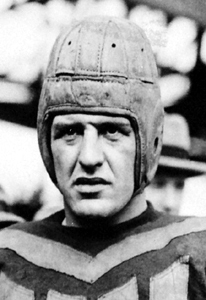 Red Grange
Red Grange
Is it me, or doesn't he favor Peyton
just the tiniest bit??In the early years, football players were paid per game. The first player to play under season-long contract was Red Grange in 1926. He was paid $100,000.00 for a 19 game season with the Chicago Bears. That may not seem like much compared to the numbers I was throwing around earlier. It's certainly less than what many players earn per game today. But factoring in inflation over the last 90 years, that works out to about $1,300,000.00 in today's money. Not bad considering he had to wear a helmet that looks like it was inspiration for a Coneheads skit.
In the early days, player salaries fluctuated wildly based on perceived skill as well as the budgets of the various teams. The players union made progress in standardizing salaries starting in the 1970s. Thanks to the popularity of the game, broadcast rights, ticket prices, and licensing revenue, there's a lot of green to go around for the players who get the hooey knocked out of them every Sunday for our entertainment. From the look of their celebration dances (and their bank account balances), they're enjoying it as much as we are.
According to various sources, the winners of Super Bowl L (50, but as a former Latin student, I'm going old school there) won $97,000.00 each. That's right. Every player on the Denver Broncos roster earned more for winning that game than many people earn in a year. The Panthers each received $49,000.00 for losing it. That will pay for a lot of tissues for wiping away the tears on the plane ride home.
 2015 champs blingNinety-seven grand is very grand indeed, but here's the kicker (pun intended): the Super Bowl bonus is literally pocket change for most of the players. The average player salary in the NFL is over $2 million per year. The regular season consists of 16 games, so that works out to about $125,000.00 per game. Teams who reach the Super Bowl have also received bonuses every time they advance in the post-season, so the total bonus take for the champs is closer to $165,000.00 per player. That doesn't include the ring each player will receive after several months of design and manufacture. The rings for last year's champs, the New England Patriots, are valued at $36,500.00 each.
2015 champs blingNinety-seven grand is very grand indeed, but here's the kicker (pun intended): the Super Bowl bonus is literally pocket change for most of the players. The average player salary in the NFL is over $2 million per year. The regular season consists of 16 games, so that works out to about $125,000.00 per game. Teams who reach the Super Bowl have also received bonuses every time they advance in the post-season, so the total bonus take for the champs is closer to $165,000.00 per player. That doesn't include the ring each player will receive after several months of design and manufacture. The rings for last year's champs, the New England Patriots, are valued at $36,500.00 each.Salaries are just the tip of the income iceberg for many professional athletes. Endorsements are where the real money is. Peyton Manning is not only the master of the game. He's an expert in product placement. Some estimate his mention of Budweiser products in his post-game interviews to be worth billions to the company, which trickles back down to him in the form of profits at the two Anheuser-Busch distributorships in which he owns a stake. And that doesn't even include the Papa John's and Nationwide contracts. (Come to think of it, I'm surprised he didn't deliver part of his canned speech to the tune of the Nationwide jingle.) Estimates of the elder Manning's annual endorsement income is $12,000,000.00. That's twelve million if all those zeroes are starting to make your eyes spin. Remember, that's on top of his 5-year, $96 million contract for actually playing football. That's just over $19 million per year, so it's more than the endorsements, but with the endorsements, 350-lb linemen are not threatening to separate your head from your shoulders on every play.
 Red Grange
Red GrangeIs it me, or doesn't he favor Peyton
just the tiniest bit??In the early years, football players were paid per game. The first player to play under season-long contract was Red Grange in 1926. He was paid $100,000.00 for a 19 game season with the Chicago Bears. That may not seem like much compared to the numbers I was throwing around earlier. It's certainly less than what many players earn per game today. But factoring in inflation over the last 90 years, that works out to about $1,300,000.00 in today's money. Not bad considering he had to wear a helmet that looks like it was inspiration for a Coneheads skit.
In the early days, player salaries fluctuated wildly based on perceived skill as well as the budgets of the various teams. The players union made progress in standardizing salaries starting in the 1970s. Thanks to the popularity of the game, broadcast rights, ticket prices, and licensing revenue, there's a lot of green to go around for the players who get the hooey knocked out of them every Sunday for our entertainment. From the look of their celebration dances (and their bank account balances), they're enjoying it as much as we are.
Published on February 15, 2016 13:10
February 3, 2016
Sports Trophies: The Golden (or Silver) Goal
It’s the final game of the season. The clock winds down. The whistle blows, the buzzer sounds, time runs out, and it’s over: one team wins it all. Along with the excitement and glory of finishing first, winning teams often receive a trophy to honor their achievement. For professional teams, the trophies are often beautiful works of art and quite valuable. Some have colorful histories every bit as exciting as the contests they honor.
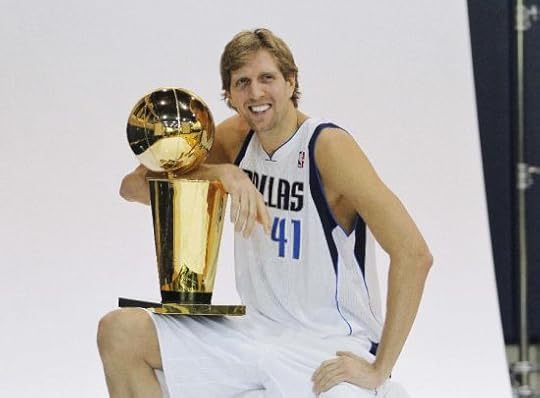 Dirk Nowitzki posing with the O'Brien trophy.
Dirk Nowitzki posing with the O'Brien trophy.
The Dallas Mavericks won the title in 2011.Youth sports team members often receive individual trophies when their teams win a tournament or championship. But the trophies for professional sports are much too expensive for one to be made for each player (although some sports like baseball and football sometimes give each player a fancy ring to wear instead). Instead, one trophy is given to the entire team. The Larry O’Brien Trophy is given each year to the winner of the National Basketball Association series winner. Standing two feet tall and weighing sixteen pounds, the gold plated figure looks like a basketball about to fall into a net (or a fancy garbage can, if you're feeling less charitable toward basketball). A new one is made for each year’s winning team. The NBA first awarded a team trophy in 1978. It was renamed for a former NBA commissioner in 1984.
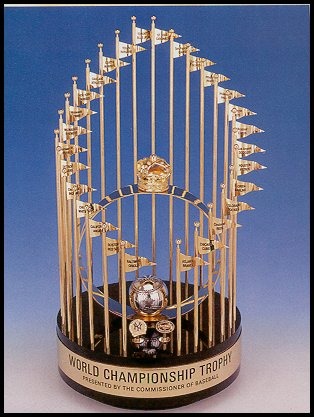 Attractive but looks rather
Attractive but looks rather
fragile IMO. There should
be bats. Wooden, not blood-
sucking.The Commissioner’s Trophy goes to the winner of baseball’s World Series. Like the O’Brien Trophy, a new trophy is made each year. Made of sterling silver but covered with a gold plating, the Commissioner’s Trophy features thirty flags representing each of the major league baseball teams. It is two feet tall and weighs about thirty pounds. The first Commissioner’s Trophy was given in 1967.
 It's been far too long since the Cowboys
It's been far too long since the Cowboys
earned one of these *sniff*.
The Lombardi Trophy is nice,
but I'm all about the bling.The Vince Lombardi Super Bowl Trophy is also made each year for the best professional football team. It is a sterling silver trophy about the same size as the basketball and baseball trophies. It features a full-size football perched atop a silver column.
Some sports don’t make a new trophy each year. Instead, there is a single trophy. The winning team gets to keep the trophy for the year they are the champions. Soccer’s FIFA World Cup trophy is given to the winner of the World Cup competition. Like the Olympics, soccer’s World Cup is held every four years. Soccer has a rich history. Its original trophy was designed in 1930. Known as the Jules Rimet Cup, it was about 14 inches high. It featured a base made of blue stone, supporting a gold woman’s winged figure with a cup above her.
 The FIFA World Cup Trophy
The FIFA World Cup Trophy
aka the Rimet CupThe Rimet Cup led an exciting life. During World War II as German troops marched across Europe, an Italian soccer federation official hid the trophy in a shoe box under his bed to keep it from falling into enemy hands. In 1966, the trophy disappeared while on display in England. It was later found buried near a tree, dug up by an enterprising dog named Pickles. The FIFA trophy disappeared again in 1983 while in the possession of the Brazil team. It was never found and is assumed to have been melted down by the thieves.
When the original FIFA trophy disappeared, it was not the only soccer trophy in existence. After Brazil had won the World Cup for the third time in 1970, they won the right to keep the trophy forever. FIFA ordered a new trophy made for subsequent winners. The new trophy was called the FIFA World Cup Trophy and the trophy rules were changed at that time. The trophy was no longer given to the winning team. Instead, the original trophy stayed with FIFA and replicas were given to the winning teams. The 1974 design is about 14 inches tall, made of 18-carat gold with a green stone base. It features two figures standing with arms upraised, embracing the globe. The trophy is engraved with the names of past winners.
 Andrew Shaw enjoying the moment when
Andrew Shaw enjoying the moment when
the Chicago Blackhawks won the
Stanley Cup in 2013, bloody face
notwithstanding. Hockey players are tough.Hockey’s trophy also has a colorful history. The hockey trophy is known as the Stanley Cup, named for Lord Stanley, Earl of Preston, one of the game’s early supporters. The first Stanley Cup was awarded in 1892. It was not designed by an artist or sculptor – Lord Stanely just went out and bought a silver cup for the princely sum of $50. It resembled the bowl-like piece atop today’s trophy. Winners’ names were simply scratched into the silver with a knife or a nail. The original cup is now on display at the Hockey Hall of Fame in Toronto.
From 1890-1930 thick silver bands were added to the base of the cup to accommodate more winners’ names. The trophy underwent some changes but eventually came to its modern form in 1958. It is by far the largest of the major sports trophies, at three feet tall and about 35 pounds. The largest silver bands, or rings, that make up the base take thirteen years to fill with the names of the winners. Once a ring is filled, it is removed and sent to the Hall of Fame for safekeeping. It is replaced with a blank ring and the process begins again.
The Stanley Cup is given to the winning team for the year they are champions. Each team member is allowed to take the trophy home for one day to share with friends and family. This has resulted in some interesting adventures for the cup while it is in private hands, including being drop-kicked onto the frozen Rideau Canal during a post-championship celebration in Ottawa.
Despite wars, thieves, and enthusiastic athletes, these trophies from the world of sports hold great meaning for the fans and players of the game. Hoisted aloft, glittering in the glare of camera flashes, they truly represent the fun and excitement of winning. That's all well and good, but in my next post which btw is just in time for Super Bowl L (that's 50 to you non-Latin speakers), I'll explain why they're really smiling by sharing with you the amount of money the players earn when their team becomes league champion.
 Handy size comparison. FIFA trophy is not shown, but
Handy size comparison. FIFA trophy is not shown, but
would be the smallest of the five.
 Dirk Nowitzki posing with the O'Brien trophy.
Dirk Nowitzki posing with the O'Brien trophy.The Dallas Mavericks won the title in 2011.Youth sports team members often receive individual trophies when their teams win a tournament or championship. But the trophies for professional sports are much too expensive for one to be made for each player (although some sports like baseball and football sometimes give each player a fancy ring to wear instead). Instead, one trophy is given to the entire team. The Larry O’Brien Trophy is given each year to the winner of the National Basketball Association series winner. Standing two feet tall and weighing sixteen pounds, the gold plated figure looks like a basketball about to fall into a net (or a fancy garbage can, if you're feeling less charitable toward basketball). A new one is made for each year’s winning team. The NBA first awarded a team trophy in 1978. It was renamed for a former NBA commissioner in 1984.
 Attractive but looks rather
Attractive but looks ratherfragile IMO. There should
be bats. Wooden, not blood-
sucking.The Commissioner’s Trophy goes to the winner of baseball’s World Series. Like the O’Brien Trophy, a new trophy is made each year. Made of sterling silver but covered with a gold plating, the Commissioner’s Trophy features thirty flags representing each of the major league baseball teams. It is two feet tall and weighs about thirty pounds. The first Commissioner’s Trophy was given in 1967.
 It's been far too long since the Cowboys
It's been far too long since the Cowboys earned one of these *sniff*.
The Lombardi Trophy is nice,
but I'm all about the bling.The Vince Lombardi Super Bowl Trophy is also made each year for the best professional football team. It is a sterling silver trophy about the same size as the basketball and baseball trophies. It features a full-size football perched atop a silver column.
Some sports don’t make a new trophy each year. Instead, there is a single trophy. The winning team gets to keep the trophy for the year they are the champions. Soccer’s FIFA World Cup trophy is given to the winner of the World Cup competition. Like the Olympics, soccer’s World Cup is held every four years. Soccer has a rich history. Its original trophy was designed in 1930. Known as the Jules Rimet Cup, it was about 14 inches high. It featured a base made of blue stone, supporting a gold woman’s winged figure with a cup above her.
 The FIFA World Cup Trophy
The FIFA World Cup Trophyaka the Rimet CupThe Rimet Cup led an exciting life. During World War II as German troops marched across Europe, an Italian soccer federation official hid the trophy in a shoe box under his bed to keep it from falling into enemy hands. In 1966, the trophy disappeared while on display in England. It was later found buried near a tree, dug up by an enterprising dog named Pickles. The FIFA trophy disappeared again in 1983 while in the possession of the Brazil team. It was never found and is assumed to have been melted down by the thieves.
When the original FIFA trophy disappeared, it was not the only soccer trophy in existence. After Brazil had won the World Cup for the third time in 1970, they won the right to keep the trophy forever. FIFA ordered a new trophy made for subsequent winners. The new trophy was called the FIFA World Cup Trophy and the trophy rules were changed at that time. The trophy was no longer given to the winning team. Instead, the original trophy stayed with FIFA and replicas were given to the winning teams. The 1974 design is about 14 inches tall, made of 18-carat gold with a green stone base. It features two figures standing with arms upraised, embracing the globe. The trophy is engraved with the names of past winners.
 Andrew Shaw enjoying the moment when
Andrew Shaw enjoying the moment whenthe Chicago Blackhawks won the
Stanley Cup in 2013, bloody face
notwithstanding. Hockey players are tough.Hockey’s trophy also has a colorful history. The hockey trophy is known as the Stanley Cup, named for Lord Stanley, Earl of Preston, one of the game’s early supporters. The first Stanley Cup was awarded in 1892. It was not designed by an artist or sculptor – Lord Stanely just went out and bought a silver cup for the princely sum of $50. It resembled the bowl-like piece atop today’s trophy. Winners’ names were simply scratched into the silver with a knife or a nail. The original cup is now on display at the Hockey Hall of Fame in Toronto.
From 1890-1930 thick silver bands were added to the base of the cup to accommodate more winners’ names. The trophy underwent some changes but eventually came to its modern form in 1958. It is by far the largest of the major sports trophies, at three feet tall and about 35 pounds. The largest silver bands, or rings, that make up the base take thirteen years to fill with the names of the winners. Once a ring is filled, it is removed and sent to the Hall of Fame for safekeeping. It is replaced with a blank ring and the process begins again.
The Stanley Cup is given to the winning team for the year they are champions. Each team member is allowed to take the trophy home for one day to share with friends and family. This has resulted in some interesting adventures for the cup while it is in private hands, including being drop-kicked onto the frozen Rideau Canal during a post-championship celebration in Ottawa.
Despite wars, thieves, and enthusiastic athletes, these trophies from the world of sports hold great meaning for the fans and players of the game. Hoisted aloft, glittering in the glare of camera flashes, they truly represent the fun and excitement of winning. That's all well and good, but in my next post which btw is just in time for Super Bowl L (that's 50 to you non-Latin speakers), I'll explain why they're really smiling by sharing with you the amount of money the players earn when their team becomes league champion.
 Handy size comparison. FIFA trophy is not shown, but
Handy size comparison. FIFA trophy is not shown, butwould be the smallest of the five.
Published on February 03, 2016 14:14



